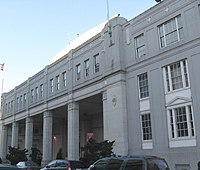Writing
The show's research team developed an annotated document, or "Writer's Notebook", which provided extended and developed definitions of the researchers' curriculum goals. The notebook assisted the writers and producers in translating their educational goals into televised material.[53] Suggestions in the notebook were free of references to specific characters and contexts on the show so that they could be implemented as openly and flexibly as possible.[17] The research team, in a series of meetings with the writers, also developed "a curriculum sheet" that described their goals and priorities for each season, which were divided into four categories: symbolic representation, cognitive processes, the physical environment, and the social environment.[54][note 5] After receiving the curriculum focus and goals for the season, the writers met to discuss ideas and story arcs for the characters, and when a script was completed, the show's research team analyzed it to ensure that the goals were met. Then each production department met to determine what each episode needed in terms of costumes, lights, and sets. The writers were present during the show's filming, which for the first twenty-four years of the show took place in Manhattan, and after 1992, at the Kaufman Astoria Studios in Queens, New York, to make last-minute revisions when necessary.[55][56]
Sesame Street has tended to use many writers in its long history. As Dave Connell, one of Sesame Street's original producers, has stated, it was difficult to find adults who could identify a preschooler's interest level. Fifteen writers a year worked on the show's scripts, but very few lasted longer than one season. Norman Stiles, head writer in 1987, reported that most writers "burn out" after writing about a dozen scripts.[59]





0 comments:
Post a Comment